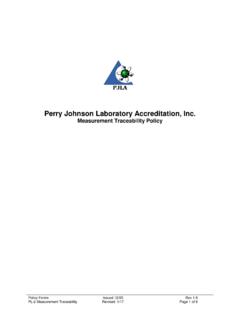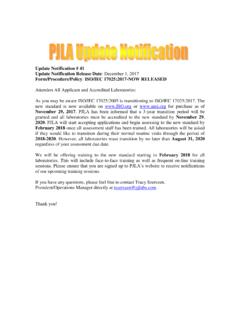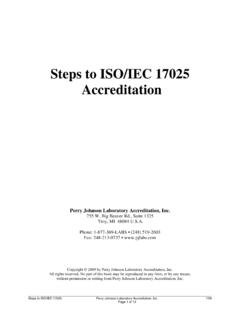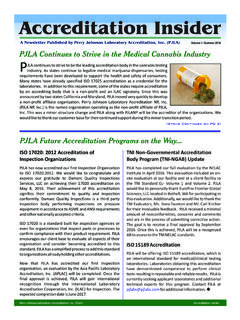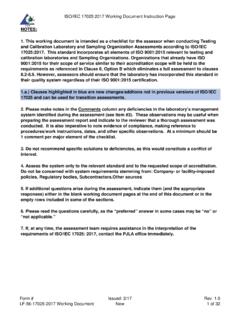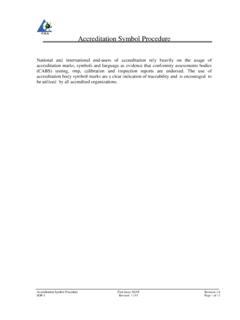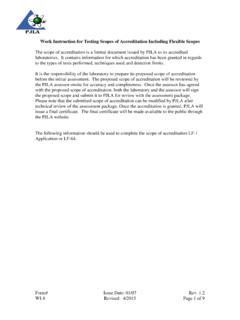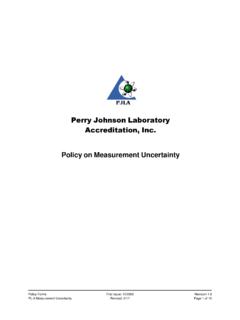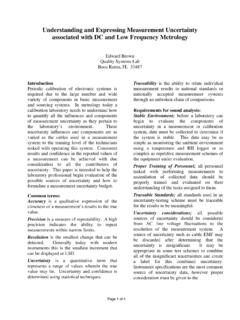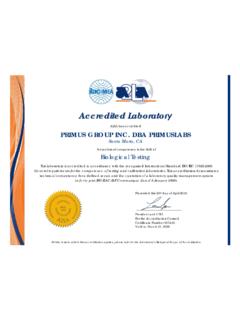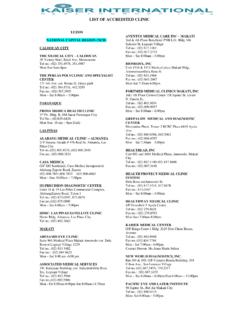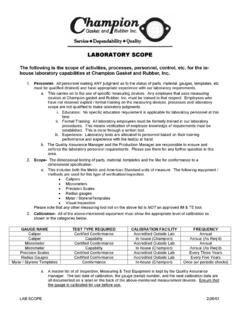Transcription of Perry Johnson Laboratory Accreditation, Inc.
1 Perry Johnson Laboratory accreditation , Inc. Proficiency Testing Requirements _____. Policy Documents Issued: 12/00 Rev PL-1 Proficiency Testing Revised: 1/17 Page 1 of 22. Proficiency Testing Requirements INTRODUCTION. Organizations seeking or maintaining accreditation shall participate in proficiency testing. The purpose of this requirement is to provide interested parties with objective evidence of an organization's capability to produce data that is both accurate and repeatable for the activities listed in its scope of accreditation . Favorable proficiency testing data can be used to demonstrate an organization's competence to clients, potential customers, accreditation bodies and other external entities.
2 Participation in proficiency testing activities also provides invaluable feedback in the internal monitoring of an organization's quality system. Through these activities, an organization can verify its competence to perform specific calibrations or tests. This document outlines PJLA's general requirements in regards to proficiency testing including: required frequencies, acceptable means of comparing and analyzing data, competency requirements and international program requirements. This document is designed based upon requirements of ISO/IEC. 17025:2005, ISO 15189:2012, ISO Guide 34/ISO 17034, ISO/IEC 17011:2004, ISO 17043 and ILAC P9.
3 Some accreditation programs have more specific requirements regarding proficiency testing, established by legislation, regulation, or specification. These may involve increased frequency, specified sources for PT, acceptability criteria, and the like. In some instances, these requirements are more stringent and comprehensive than those mandated as referenced above and PJLA's own requirements as detailed in this document. In such cases PJLA will enforce such requirements by exercising its responsibility as a recognized accrediting body for these programs ( DoD ELAP, EPA NLLAP, TNI EL Program). Note: Specific PT criteria for PJLA's Medical Laboratory Program (ISO.)
4 15189) are detailed in Appendix A of this policy. Appendix A and the body of the main policy shall be adhered to for medical laboratories. PROFICIENCY TESTING SPECIFIC REQUIREMENTS 17025:2005 TESTING AND/ OR. CALIBRATION LABORATORIES (INCLUDES PROGRAMS UTILIZING 17025 AS A BASELINE. DOCUMENT. Two terms which appear frequently in the discussion of proficiency testing and for which internationally recognized definitions do not currently exist are Discipline and Sub-discipline. The following definitions for these terms have been established by PJLA to apply to all procedures and documents, both internal and external, wherein an organization's calibration or testing capabilities are stated or referenced.
5 This applies as well to all procedures and documents, both internal and external, from organizations accredited by PJLA. In order to maintain consistency of interpretation of procedures, documents, and requirements to which these terms relate, any questions regarding their use will be decided at the discretion of PJLA's technical staff having given due consideration to any opposing points of view from all interested parties. _____. Policy Documents Issued: 12/00 Rev PL-1 Proficiency Testing Revised: 1/17 Page 2 of 22. Proficiency Testing Requirements Definitions: Calibration or Testing Discipline : A category of calibrations or set of test intended to quantify or evaluate common or related parameters of a unit, device or substance submitted for calibration or test.
6 Calibration or Testing Sub-discipline : At a minimum a sub discipline is an element of an associated calibration or test discipline for which the magnitude of a stated parameter has been defined as a measurement objective and will be determined by a specified method using appropriate skills and equipment. A sub-discipline may be composed of one or more such elements where the organization has determined that the measurement objective, the specified method and the appropriate equipment are either identical or similar to such a degree that they can be considered as mutually representative. In addition the organization shall have determined that the successful performance of either would be satisfactory objective evidence of the technical competence necessary to successfully perform the other.
7 The organization must document the basis for its decision to group multiple elements of a discipline into a single composite sub- discipline. Such documentation shall be available for review by an assessor at the time of assessment or at other times as requested by PJLA. PJLA currently accredits organizations in the following disciplines: Calibration: Acoustic Chemical Dimensional Electrical Mass, Force, and Weighing Devices Mechanical Optical Thermodynamic Time and Frequency Testing: Acoustical Biological Chemical Dimensional Inspection Electrical Environmental Optical Mechanical Microbiological Non-Destructive Thermodynamic _____.
8 Policy Documents Issued: 12/00 Rev PL-1 Proficiency Testing Revised: 1/17 Page 3 of 22. Proficiency Testing Requirements Calibration discipline and sub-discipline examples: FIG. DIMENSIONAL. MEASURED RANGE OR CALIBRATION CALIBRATION. INSTRUMENT, NOMINAL DEVICE AND EQUIPMENT AND. QUANTITY OR SIZE AS MEASUREMENT REFERENCE. GAUGE APPROPRIATE CAPABILITY STANDARDS USED. EXPRESSED. AS AN. UNCERTAINTY ( ). Micrometer in to 12 in (56 + ) in Gage Blocks Dial Indicator 0 in to 4 in (610 + 27L) in Gage Blocks and Surface Plate Caliper in to 12 in (112 + ) in Gage Blocks FIG. ELECTRICAL. MEASURED RANGE OR CALIBRATION CALIBRATION. INSTRUMENT, NOMINAL DEVICE AND EQUIPMENT AND.
9 QUANTITY OR SIZE AS MEASUREMENT REFERENCE. GAUGE APPROPRIATE CAPABILITY STANDARDS USED. EXPRESSED. AS AN. UNCERTAINTY ( ). Equipment to Measure Fluke 5500A-SC300. AC Voltage Calibrator at the listed frequencies 10 Hz to 45 Hz 1 mV to 33 mV 10 Hz to 45 Hz 45 Hz to 10 kHz 1 mV to 33 mV 45 Hz to 10 kHz 10 kHz to 20 kHz 1 mV to 33 mV 10 kHz to 20 kHz Equipment to 9 V to 330 mV 60 V/V + 3 V Fluke 5500A-SC300. Measure 330 mV to V 50 V/V + 5 V Calibrator DC Voltage V to 33 V 50 V/V + 50 V. 33 V to 330 V 55 V/V + 500 V. 330 V to 1 000 V 55 V/V + 1500 V. Equipment to to m / + Fluke 5500A-SC300. Measure Calibrator Resistance 11 to 33 m / +.
10 33 to 110 90 / + . 110 to 330 90 / + . 330 to k 90 / + . k to k 90 / + . The calibration scope example above has two disciplines, Dimensional and Electrical. For the dimensional discipline the organization has determined that the measurement objective, the specified method and the appropriate skills and equipment used to calibrate micrometers and to calibrate calipers are either identical or similar to such a degree that they can be considered as mutually _____. Policy Documents Issued: 12/00 Rev PL-1 Proficiency Testing Revised: 1/17 Page 4 of 22. Proficiency Testing Requirements representative. In addition the organization has determined that the successful performance of either would be satisfactory objective evidence of the technical competence necessary to successfully perform the other.
